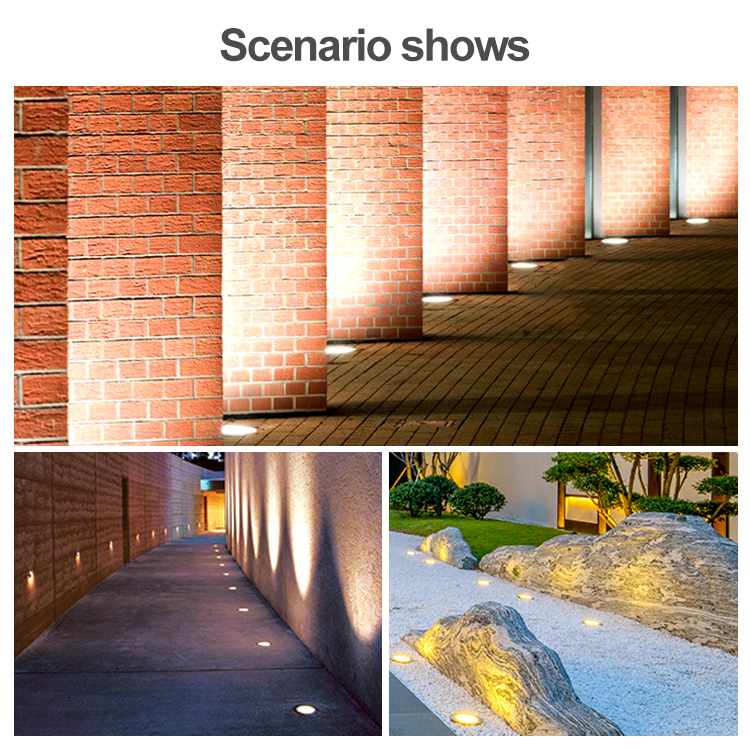In architectural and landscape lighting, precision is everything. Adjustable underground lights—also called tiltable in-ground LED lights—provide the perfect solution when you need powerful illumination from below, with complete control over beam direction. Whether highlighting a tree, statue, column, or building façade, these recessed fixtures allow for adjustable beam angles to fine-tune the lighting effect without changing the light’s position. At our LED lighting factory, we manufacture a wide range of adjustable LED underground lights built to perform in challenging outdoor environments. Engineered with IP67–IP68 waterproof ratings, robust heat dissipation, and mechanical angle-adjustment mechanisms, our products combine function, form, and durability—ideal for professional outdoor lighting projects. An adjustable inground light is a recessed outdoor LED fixture installed flush with the ground, offering the ability to tilt or rotate the internal light module to direct the beam upward at various angles. This enables precise illumination of vertical structures or focal points—without needing to reposition the entire fixture. Common applications include uplighting trees, signage, sculptures, walls, or pillars in residential gardens, commercial plazas, hotel landscapes, and municipal spaces. The internal light source can be tilted (usually up to 30–45 degrees) to aim the light exactly where needed—minimizing light spill and enhancing visual accuracy. Ideal for tree uplighting, wall grazing, architectural highlighting, and signage illumination, where static beam angles fall short. With IP65/IP67 waterproofing, IK-rated impact resistance, and anti-corrosion housings, our adjustable underground lights are built for driveways, wet areas, and harsh environments. Using high-efficacy LED chips, our products deliver strong lumen output with low energy use, reducing power consumption and maintenance costs. We offer various wattages, beam angles, finishes, and color temperatures (2700K–6500K or RGB). Motion-sensor and smart-control options are also available. Architectural Wall Grazing – Illuminate building facades, columns, or gates with precise uplight. Tree and Palm Lighting – Tilt the beam to reach higher tree canopies or trunks from the base. Signage and Monument Lighting – Highlight directional signage or artistic features without fixture intrusion. Sculpture and Focal Points – Direct the beam to draw attention to specific objects in parks or courtyards. Poolside & Garden Edges – IP68 versions work near water features or in soil-heavy landscapes. Adjustable Inground Light, Adjustable Ground Light, Adjustable Step Light, Adjustable Buired Light, Adjustable Led Underground Light Jiangmen Synno Lighting Co., Ltd. , https://www.synnoled.com
Adjustable LED Underground Lights for Landscape & Architecture
What Is an Adjustable Underground Light?
Key Benefits of Adjustable Underground Lights
✅ 1. Flexible Beam Direction
✅ 2. Professional Landscape & Façade Lighting
✅ 3. Rugged Outdoor Design
✅ 4. Energy-Saving LED Technology
✅ 5. Customization Options
Where to Use Adjustable Underground Lights
According to a report released on December 27, the Japan Aluminum Association revealed that aluminum rolled material shipments in Japan dropped by 7% in November, marking the first decline in two months. This decrease was primarily attributed to weak demand from automakers and construction companies.
The association stated that in November, the supply of aluminum rolled products—both for domestic use and exports—reached 160,556 tons, down from 172,576 tons recorded during the same period last year. The drop highlights a slowdown in industrial activity and reflects broader economic challenges facing key sectors in Japan.
Members of the Japan Aluminum Association include major companies such as Furukawa-Sky Aluminum Corp., Kobe Steel Ltd., and Nippon Light Metal Co., which play a significant role in the country's aluminum production and distribution.
The decline comes amid ongoing global supply chain issues and a sluggish recovery in post-pandemic demand. Analysts suggest that the automotive industry, in particular, is still feeling the effects of reduced consumer spending and shifting market trends.
As the industry looks ahead, it remains to be seen whether this dip is a temporary setback or a sign of longer-term structural changes in demand. For now, Japanese aluminum producers are likely to monitor market conditions closely as they adjust their strategies for the coming months.